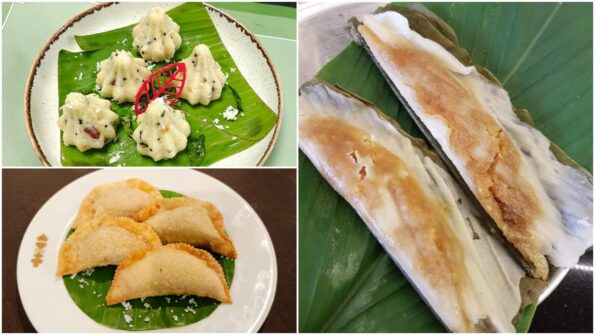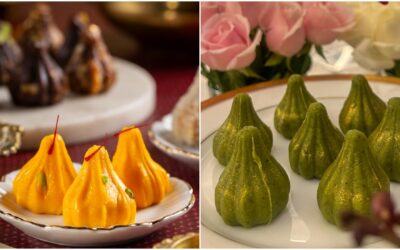Ganesh Chaturthi: Enjoy savoury dishes during by following the recipes

[[{“value”:”
Ganesh Chaturthi is a time for feasting, and while sweet modaks are the star, the celebration is truly a full culinary experience. Beyond the beloved sweets, traditional savoury dishes are at the heart of the festive spread. From rustic steamed rice cakes to spicy fried parcels, these dishes offer a delicious twist on classic festive fare.
Dive into the simple, earthy flavours of Nivagrya, a Maharashtrian staple, or try the humble yet divine Uppu Arisi Kozhukattai, a savoury rice and coconut delicacy. For those who love a bit of spice, the Spicy Coconut Nevri from Goa and the aromatic Masala Chun Patholya from Maharashtra are perfect additions to your festive menu.
This Ganesh Chaturthi, bring joy to your home with every bite with these recipes offer a delicious twist on classic festive fare.
Steamed Nivagrya
Nivagrya is a rustic Maharashtrian preparation made from rice flour dough, seasoned with fresh spices and steamed to perfection. “Traditionally enjoyed with a drizzle of ghee, this dish balances earthy flavours with subtle heat from green or red chilies. Steaming makes it light on the stomach, yet filling enough to be served as a wholesome snack or a light meal,” shares Nitin Borate, executive sous chef, The Westin, Pune Koregaon Park.
Ingredients
Rice flour (preferably Ambemohar or Tukda Basmati Rice) 1 cup
Water 1 cup
Ghee (plus extra for serving) 1 tsp
Oil 1 tsp
Salt 1 tbsp
Fresh green or red chili coarse paste 1 tbsp
Cumin seeds 2 tsp
Fresh coriander, finely chopped ¼ cup
Fresh ginger paste 1 tsp
Method:
1. Prepare the rice dough base: In a heavy-bottomed pan, add water, salt, and oil. Bring to a rolling boil. Lower the flame, add the rice flour, and mix quickly. Cover and cook on the lowest flame for 2 minutes. This mixture is called ukad.
2. Knead the dough: Remove the pan from heat and let the ukad cool for about 5 minutes. Transfer it onto a flat thali or clean surface. Add coriander, cumin seeds, ginger paste, and chili paste, and knead until a soft, pliable dough ball forms.
3. Shape the Nivagrya: Divide the dough into lemon-sized balls. Gently flatten each into small discs (approx. 0.5 cm thick). These are called nivagrya.
4. Steam: Heat water in a pot and place a sieve or steamer insert on top. Line with muslin cloth, banana leaves, or lightly oil the base. Arrange the nivagrya and steam for 15 minutes on high flame.
5. Serve: Remove carefully, allow to cool slightly, and serve hot with a generous dollop of ghee.
Uppu Arisi Kozhukattai
“Ganpati Bappa is known as the harbinger of new beginnings, and food is an integral part of every celebration in His honour. These Uppu Arisi Kozhukattais, humble yet divine, are not just offerings but a way of invoking purity, love, and tradition in our homes. Each bite is a blessing, a reminder that simple ingredients can create sacred joy,” says chef Yashwant Sopane, Sayaji Hotel Pune.
Ingredients
For the Kozhukattai
Raw Maavu rice 250 gm
Salt 1.5 tsp
Coconut grated 25 gm
Water minimum to grind
For the seasoning/tadka:
Mustard seeds
Urad dhal
Dried red chillies
Asafoetida powder
Curry leaves
Cooking oil of choice (all to taste)
Method:
1. Wash the raw rice, soak for 30 minutes, drain, add salt, and grind coarsely with about one ladle of water.
2. Add coconut and grind for one quick round to get a coarse batter.
3. Heat this batter in a kadai, add about half a cup of water, and cook while stirring until the batter thickens so that it can be rolled into balls.
4. Roll the batter into small balls (kozhukattais) and set aside.
5. Grease an idli plate with oil, lay out the kozhukattais, and steam in a cooker. Let the steam build on high heat for 5 minutes, then turn down the flame and cook for another 2 minutes before turning off the flame.
6. You can serve right away or make a spiced-up version by cutting the kozhukattais into halves. Make a tadka of oil and the seasoning ingredients, then add in the cut kozhukattais and toss for a few minutes.
Spicy Coconut Nevri
Nevri (also called Neureo, Gujiya, or Karanji) is a traditional Goan delicacy prepared during Diwali and Ganesh Chaturthi. “While often made with sweet fillings, this spicy coconut version offers a savoury twist with a subtle kick of flavours,” says Jotiba Pakhare, chef de partie, Deltin Suites Goa.
Ingredients:
For the dough:
Maida (all-purpose flour 2 cups
Rawa (fine semolina) 2 tbsp
Salt 1/2 tsp
Oil or ghee 2 tbsp (heated, for moyan)
Water as required (to knead stiff dough)
For the filling:
Fresh grated coconut 1 1/2 cups
Green chillies, finely chopped 3 to 4 nos
Curry leaves, chopped 6 to 8
Coriander leaves, chopped 2 tbsp
Mustard seeds 1 tsp
Cumin seeds 1/2 tsp
Red chilli powder 1 tsp (adjust to taste)
Turmeric powder 1/4 tsp
Garam masala 1/2 tsp
Salt to taste
Oil 2 tbsp (for roasting filling)
For frying:
Oil for deep frying
Method:
1. Prepare the dough: In a mixing bowl, combine maida, rawa, and salt. Add hot oil/ghee (moyan) and rub into the flour mixture. Gradually add water and knead into a stiff, smooth dough. Cover with a damp cloth and let it rest for 20 to 30 minutes.
2. Prepare the filling: Heat oil in a pan and splutter mustard and cumin seeds. Add curry leaves and chopped green chillies; sauté until fragrant. Stir in turmeric, red chilli powder, and garam masala. Add grated coconut and cook for 2 to 3 minutes until the mixture is slightly dry. Season with salt, mix in chopped coriander leaves, and allow to cool completely.
3. Shaping the nevri: Divide the dough into lemon-sized balls and roll into 3 to 4-inch discs. Place 1 to 2 tbsp of filling in the centre of each disc. Fold into a half-moon shape and seal the edges by pressing, twisting, or using a fork/nevri cutter.
4. Frying: Heat oil in a deep pan on a medium flame. Fry nevries in batches until crisp and golden brown. Remove and drain on absorbent paper.
Masala Chun Patholya
“A traditional Maharashtrian delicacy, Patolya combines the earthy aroma of turmeric leaves with the wholesome goodness of rice flour and spiced fillings,” says Santosh Sakpal, executive chef, St. Fort JadhavGadh. Perfect for festive celebrations like Ganesh Chaturthi, this recipe balances nostalgia and flavour in every bite.
Ingredients:
For the dough
Rice flour 50 gm
Milk 15 ml
Water as required to steam dough
For the filling
Amchur powder 5 gm
Elaichi powder 3 gm
Garam masala powder 5 gm
Haldi (turmeric) powder 5 gm
Jeera powder 5 gm
Chaat masala 2 gm
Salt to taste
Green peas 100 gm
Potato (boiled) 10 gm
Lemon juice 5 ml
For the tempering and assembly:
Curry leaves 3 to 4 no
Desi ghee 20 gm
Jeera (cumin seeds) 5 gm
Mustard seeds 5 gm
Turmeric (haldi) leaves 4 nos
Method:
1. Prepare the dough: Mix rice flour with warm milk and water, kneading into a soft, smooth dough. Cover and rest.
2. Make the filling: In a pan, heat desi ghee. Add mustard seeds, cumin, and curry leaves. Add boiled green peas and mashed potato. Season with haldi powder, amchur powder, garam masala, jeera powder, chaat masala, salt, and a squeeze of lemon juice. Cook until well combined and aromatic, then allow to cool.
3. Assemble the patolya: Wash and pat dry turmeric leaves. Spread a thin layer of rice dough over each leaf. Place the prepared masala filling in the centre and fold the leaf carefully.
4. Steam: Place the folded leaves in a steamer and cook until the rice dough turns translucent and the aroma of turmeric leaves seeps through.
5. Serve: Gently unwrap the steamed parcels and serve hot with a drizzle of desi ghee.
“}]]
Search
Recent
- ‘Bhairav commandos’: Indian army gets specially equipped soldiers; first of 5 units being raised
- Houses flooded, goods destroyed as Mohali gets flooded
- Ambala on alert as Tangri level rises, Haryana minister Anil Vij reviews situation
- Flooded border area halts retreat parade at Hussainiwala
- Finally, MoD grants medical facilities to disabled officer cadets


